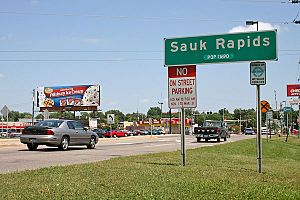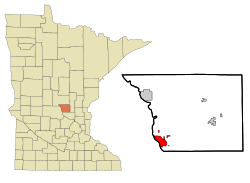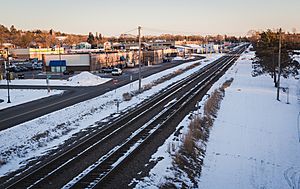Sauk Rapids, Minnesota facts for kids
Quick facts for kids
Sauk Rapids
|
|
|---|---|
 |
|

|
|
| Country | United States |
| State | Minnesota |
| County | Benton |
| Area | |
| • Total | 6.52 sq mi (16.89 km2) |
| • Land | 6.29 sq mi (16.28 km2) |
| • Water | 0.23 sq mi (0.61 km2) |
| Elevation | 1,079 ft (329 m) |
| Population
(2020)
|
|
| • Total | 13,862 |
| • Density | 2,204.52/sq mi (851.22/km2) |
| Time zone | UTC-6 (CST) |
| • Summer (DST) | UTC-5 (CDT) |
| ZIP code |
56379
|
| Area code(s) | 320 |
| FIPS code | 27-58684 |
| GNIS feature ID | 2396542 |
Sauk Rapids is a city located in Benton County, Minnesota, United States. In 2020, about 13,862 people lived there. This city is found on the Mississippi River, right where the Sauk River joins it. The city gets its name from the "rapids" or fast-moving water in the river. Sauk Rapids is also part of the larger St. Cloud metropolitan area.
Contents
History of Sauk Rapids

Sauk Rapids was once a thick forest of oak, maple, and basswood trees. The first house was built here in 1851. It was a large home called Lynden Terrace. More settlers soon arrived and built their homes. The town was named Sauk Rapids because of the fast-moving water in the Mississippi River nearby. This new settlement was also along the Red River Trails, which were important travel routes.
Early Buildings and Growth
Soon after, a general store was built in the town. Then came a hotel and a large jail. The first settlers also started a church. Other churches, like Methodist, Episcopalian, and Lutheran ones, were built later. The first newspaper outside of St. Paul was the Sauk Rapids Frontiersman. It started in 1854.
A flour mill was built in 1875, but it was destroyed in 1886. The first bridge was built in 1876. It was also destroyed later that same year, but it was rebuilt in 1879. The first school in Sauk Rapids was built in 1886.
Railroad and Transportation
In 1874, Sauk Rapids became the end of the railroad line. This was a big deal for the town. Farmers and traders from far away, like the Red River Valley, brought their goods here to ship them. A six-horse stagecoach also traveled between St. Cloud and Crow Wing twice a week.
County Seat Changes
The county seat, which is where the main government offices are, moved to Watab in 1856. It came back to Sauk Rapids in 1859. A new courthouse was built. However, in 1897, the county seat moved again to Foley, where it is today. The courthouse in Sauk Rapids burned down in 1917.
The 1886 Tornado
Sauk Rapids was a very important city in Minnesota until 1886. On April 14, a powerful tornado hit the town. It swept through the center of the city, destroying all the stores. The tornado caused a lot of damage. Many people were injured, and 44 people lost their lives in Sauk Rapids.
New Bridge Construction
The Sauk Rapids Regional Bridge was finished in 2007. This new bridge connects to 2nd Street. The old bridge connected to 1st Street. Some buildings had to be taken down to build the new bridge. However, some of them were rebuilt. Some sidewalks were also repaved with cobblestone, and the middle sections of roads were filled with granite blocks.
Geography
Sauk Rapids covers an area of about 6.35 square miles (16.45 square kilometers). Most of this area is land, and a small part is water.
Main Roads
U.S. Highway 10 and Minnesota State Highway 15 are two of the main roads in Sauk Rapids. Other important roads nearby include Interstate 94/U.S. Highway 52, Minnesota State Highway 23, and County Road 75. Sauk Rapids is located just northeast of St. Cloud, on the east side of the Mississippi River.
Population Information
| Historical population | |||
|---|---|---|---|
| Census | Pop. | %± | |
| 1860 | 167 | — | |
| 1870 | 412 | 146.7% | |
| 1880 | 598 | 45.1% | |
| 1890 | 1,185 | 98.2% | |
| 1900 | 1,391 | 17.4% | |
| 1910 | 1,745 | 25.4% | |
| 1920 | 2,349 | 34.6% | |
| 1930 | 2,656 | 13.1% | |
| 1940 | 2,981 | 12.2% | |
| 1950 | 3,410 | 14.4% | |
| 1960 | 4,038 | 18.4% | |
| 1970 | 5,051 | 25.1% | |
| 1980 | 5,793 | 14.7% | |
| 1990 | 7,825 | 35.1% | |
| 2000 | 10,213 | 30.5% | |
| 2010 | 12,773 | 25.1% | |
| 2020 | 13,862 | 8.5% | |
| U.S. Decennial Census 2020 Census |
|||
In 2010, there were 12,773 people living in Sauk Rapids. There were 4,960 households. About 36.6% of these households had children under 18. The average age of people in the city was 32.8 years old. About 25.9% of residents were under 18 years old.
Parks and Recreation
Sauk Rapids has many places for fun and outdoor activities. The city has 22 parks and nature preserves. There are also paved walking paths and playgrounds. You can find tennis courts, baseball fields, and soccer fields. The city also has a golf course, a public splash pad, and a wading pool for swimming.
Education
Sauk Rapids has several schools. There are four public schools: Mississippi Heights Elementary, Pleasantview Elementary, Sauk Rapids-Rice Middle School, and Sauk Rapids-Rice High School. There is also one private school called Petra Lutheran School.
Media
The Sauk Rapids Herald is the local newspaper. It is published once a week on Saturdays.
Notable People
Many interesting people have connections to Sauk Rapids:
- Raymond H. Bares was a state senator and educator in Minnesota.
- Jerry Bauerly was a state representative, businessman, and educator.
- James Beatty was an early settler and a lawmaker in the Minnesota Territory.
- Oliver Chirhart was the mayor of Sauk Rapids. He was also a state representative, teacher, and businessman.
- Lewis Mayo was a state senator, doctor, and lawyer.
- Bridget Jones Nelson is a screenwriter and actress. She worked on shows like Mystery Science Theater 3000.
- Rip Repulski was a professional baseball player who was an MLB All-Star.
- Walter F. Rogosheske was a judge and lawmaker in Minnesota.
- Jeremiah Russell was an early settler and a lawmaker in the Minnesota Territory.
See also
 In Spanish: Sauk Rapids (Minnesota) para niños
In Spanish: Sauk Rapids (Minnesota) para niños

